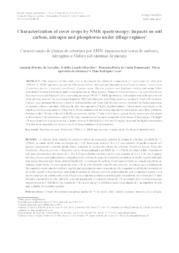Characterization of cover crops by NMR spectroscopy: impacts on soil carbon, nitrogen and phosphorus under tilage regimes.
Characterization of cover crops by NMR spectroscopy: impacts on soil carbon, nitrogen and phosphorus under tilage regimes.
Autoria: CARVALHO, A. M. de; MARCHAO, R. L.; BUSTAMANTE, M. M. da C.; ALCANTARA, F. A. de; COSER, T. R.
Resumo: The objective of this study was to investigate the chemical composition of cover crops by solid-state CPMAS 13C NMR spectroscopy and its effects on carbon, nitrogen and phosphorus in a Typic Acrustox. Cover crops (Crotalaria juncea, Canavalia brasiliensis, Cajanus cajan, Mucuna pruriens and Raphanus sativus) and natural fallow were studied in rotation with maize under conventional and no-tillage regimes. Tissues of Crotalaria juncea, Canavalia brasiliensis, Mucuna pruriens and Raphanus sativus were analyzed using CPMAS 13C NMR spectroscopy. Soil samples were collected at the end of the growing season of the cover crops (September 2002) and during the grain filling period in corn from 0-5 and 5-10 cm layers. Cajanus cajan presented the lowest content of polysaccharides and along with Mucuna pruriens presented the highest percentage of aromatic carbon compounds, reflecting the slow decomposition of highly lignified material. Carbon stocks were higher in the superficial soil layer and under no-tillage due to the accumulation and slower decomposition of plant tissues under these conditions. Increases in the C/N ratio of the soil with Mucuna pruriens and the C/P ratio with Cajanus cajan in the dry season were also related to slower rates of decomposition, caused by the large concentration of aromatic compounds in the tissues of these species. The higher C/P ratios found at 0-5 cm layer are due to higher values of P (Mehlich-1) at 5-10 cm (25 mg kg-1) layer and the higher concentration of carbon in the superficial soil layer as a result of the accumulation of plant residues.
Ano de publicação: 2014
Tipo de publicação: Artigo de periódico
Unidade: Embrapa Arroz e Feijão
Palavras-chave: Carbono, Cerrado, Latossolo Vermelho-Amarelo, Matéria Orgânica, Planta de Cobertura, Ressonância magnetica nuclear
Observações
1 - Por padrão são exibidas publicações dos últimos 20 anos. Para encontrar publicações mais antigas, configure o filtro ano de publicação, colocando o ano a partir do qual você deseja encontrar publicações. O filtro está na coluna da esquerda na busca acima.
2 - Para ler algumas publicações da Embrapa (apenas as que estão em formato ePub), é necessário ter, no celular ou computador, um desses softwares gratuitos. Sistemas Android: Google Play Livros; IOS: iBooks; Windows e Linux: software Calibre.
Acesse outras publicações
Acesse a Base de Dados da Pesquisa Agropecuária (BDPA) para consultar o acervo completo das bibliotecas da Embrapa.

